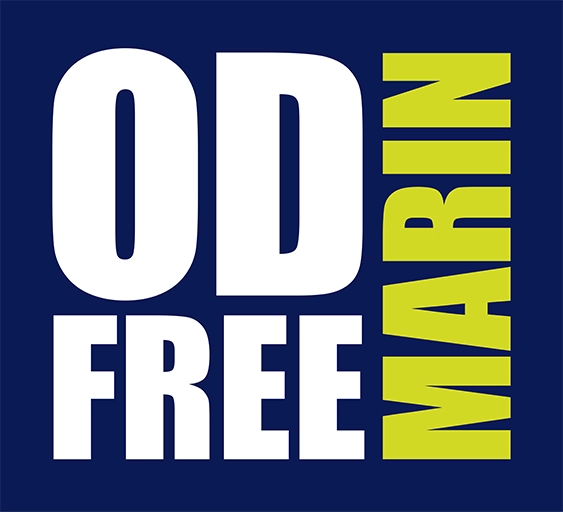Data Dashboard
Marin County Overdose Data
Overdose is the leading cause of death for Marin County residents aged 55 and under. Fentanyl is driving these overdoses and is associated with approximately 60% of overdose deaths in the county. The following data are intended to track trends and provide information for shared understanding and action across our county. OD Free Marin strives to prevent overdoses through data-driven strategies and community collaboration.
Non-Fatal Opioid Overdose
The following dashboard shows information on clinically confirmed and suspected opioid overdose events in Marin County. These events are identified by signs, symptoms and diagnosis codes reported in EMS data. Non-fatal overdose is a risk for future fatal overdose. Tracking non-fatal overdose events provides valuable insights to guide prevention strategies. Spikes in non-fatal overdoses may signal the presence of particularly potent substances in the drug supply, including fentanyl.
Data Source: ImageTrend EMS data
Data notes
In March 2025, The OD Free Marin Steering Committee approved a shifted focus of this dashboard from showing all substance-related events to displaying only confirmed and suspected opioid overdose and events that involved opioids and another substance. This suggestion came from Marin County EMS and Epidemiology Teams. Because different substances may require different interventions, disaggregating these events can help us create more effective and tailored strategies to address substance use, and in particular opioid overdose, in Marin. While these updated data reflect a decrease in total numbers of overdose events as compared to prior versions of the dashboard, OD Free Marin and Marin HHS are still actively reviewing all substance-related events.
Marin Health & Human Services (HHS) uses Emergency Medical Services (EMS) records from all 911 calls to identify suspected drug overdoses. A single overdose can include multiple substances. These records include both intentional and unintentional overdoses. Results are updated in the first week of each month.
* Data for the current year is complete as of the data refreshed date. ** Counts are not mutually exclusive. All events listed are opioid related events. The polysubstance events are subgroups of this larger “All Opioids” count. *** Race/Ethnicity information became a mandatory field starting in 2021.
****Data recorded on 911 calls for gender only include Male or Female, limiting our understanding of the experience of those who may identify with other gender identities. We are sharing data collected that identifies the binary sex reported at the time of the 911 call as only Male or Female and thus recognize that this limits our understanding of those impacted who identify in other ways.
Fatal Overdose
OD Free Marin sees overdose deaths as preventable. We aim to reverse this trend by raising awareness, coordinating action, and directing resources to prevent overdose and save lives.
Data Source: VRBIS data
Data notes
Death investigations conducted by the Marin County Sheriff-Coroner for drug overdoses may take six months to a year, leading to delays in tallies of fatal events. 2023 data is now available with a few additional records under investigation and it presents an unchanged trend in the number of overdose deaths compared to 2022. These records include both intentional and unintentional overdoses. Results are updated each month.
* Counts are not mutually exclusive, meaning one overdose event can include multiple types of drugs.
**Data recorded on death certificates for gender only include Male or Female, limiting our understanding of the experience of those who may identify with other gender identities. We are sharing data collected that identifies the binary sex reported on the death certificate as only Male or Female and thus recognize that this limits our understanding of those impacted who identify in other ways.
Free Naloxone Distribution Dashboard
This dashboard shows naloxone kits given for free in Marin County to help prevent opioid overdose. Naloxone is a life-saving medicine that can reverse overdoses. It’s also available for purchase online and at pharmacies. We aim to make naloxone accessible without cost, raising awareness about its importance. OD Free Marin provides naloxone through vending machines, Naloxboxes, and community events. For free naloxone and training videos (in English and Spanish) visit our naloxone page.
Data Source: Naloxone vending machine data are provided by Behavioral Health and Recovery Services (BHRS), Department of Health and Human Services (HHS)
Treatment for Opioid Use Disorder: Buprenorphine and Methadone Prescriptions
Buprenorphine and methadone are medications that effectively treat Opioid Use Disorder (OUD) and reduce the risk of overdose. The fentanyl crisis has increased demand for these therapies, and improving access to treatment is an OD Free Marin goal. Learn more, including where to access treatment for opioid use disorder on our Medication Assisted Treatment (MAT) page.
Data Source: California Controlled Substance Utilization Review and Evaluation System (CURES), California Prescription Drug Monitoring Program (PDMP)
Data notes
Buprenorphine prescriptions are reported by dispensing pharmacies to the California Prescription Drug Monitoring Program (PDMP). Marin County Department of Health and Human Services updates results here semi-annually.
Opioid Prescriptions, Marin County, 2008-2022
Safe and appropriate prescribing is a goal of OD Free Marin. Historically, opioid overprescribing fueled the opioid overdose epidemic. Tracking opioid prescriptions (by morphine equivalent) in Marin allows us to see trends in “opioid prescription burden,” or the negative health impacts of overprescribing over time. Additional details can be found on the California Opioid Overdose Surveillance Dashboard.
Data Source: California Controlled Substance Utilization Review and Evaluation System (CURES), California Prescription Drug Monitoring Program (PDMP)
